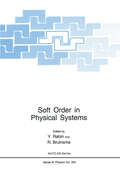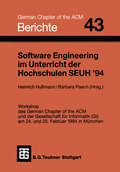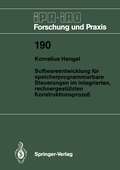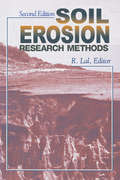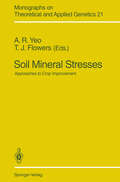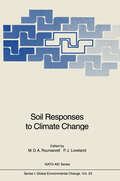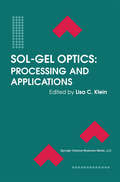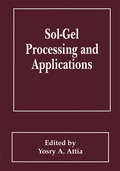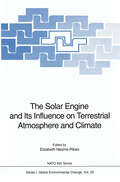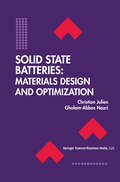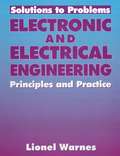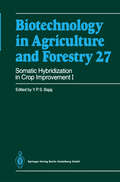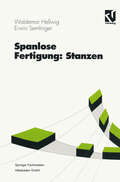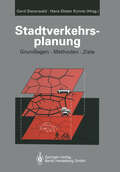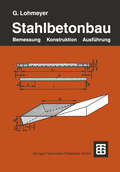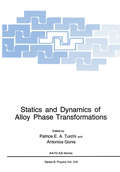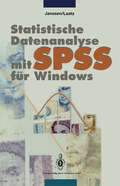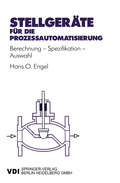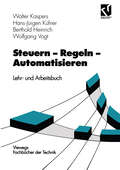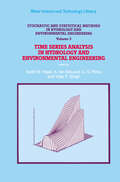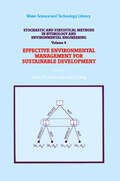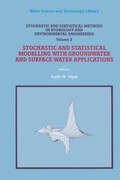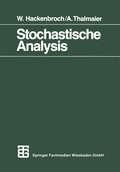- Table View
- List View
Soft Order in Physical Systems (Nato Science Series B: #323)
by R. Bruinsma Y. RabinA humoristic view of the physics of soft matter, which nevertheless has a ring of truth to it, is that it is an ill-defined subject which deals with ill-condensed matter by ill-defined methods. Although, since the Nobel prize was awarded to Pierre-Gilles de Gennes, this subject can be no longer shrugged-away as "sludge physics" by the physics community, it is still not viewed universally as "main stream" physics. While, at first glance, this may be considered as another example of inertia, a case of the "establishment" against the "newcomer", the roots of this prejudice are much deeper and can be traced back to Roger Bacon's conception about the objectivity of science. All of us would agree with the weaker form of this idea which simply says that the final results of our work should be phrased in an observer-independent way and be communicable to anybody who made the effort to learn this language. There exists, however, a stronger form of this idea according to which the above criteria of "objectivity" and "communicability" apply also to the process of scientific inquiry. The fact that major progress in the physics of soft matter was made in apparent violation of this approach, by applying intuition to problems which appeared to defy rigorous analysis, may explain why many physicists feel somewhat ill-at-ease with this subject.
Software Engineering im Unterricht der Hochschulen SEUH ’94 (Berichte des German Chapter of the ACM)
by Heinrich Hussmann Barbara PaechSoftwareentwicklung für speicherprogrammierbare Steuerungen im integrierten, rechnergestützten Konstruktionsprozeß (IPA-IAO - Forschung und Praxis #190)
by Kornelius HengelSoil Erosion Research Methods
by Soil and Water Conservation Society (U. S.)This new edition of Soil Erosion Research Methods retains the themes and layout of the first edition. However, most chapters have been revised and some additional chapters have been added. There are new chapters on modeling wind and water erosion. Extensive revisions and updating have been done in chapters dealing with assessment of erosivity and erodibility, erosion, crop productivity, measuring sediment yield from river basins and field plot techniques. There is extensive updating of current statistics on the global magnitude of soil erosion by water and wind and on denudation rates. Several new authors have made significant improvements in revising and updating available information.
Soil Erosion Research Methods
by Soil and Water Conservation Society (U. S.)This new edition of Soil Erosion Research Methods retains the themes and layout of the first edition. However, most chapters have been revised and some additional chapters have been added. There are new chapters on modeling wind and water erosion. Extensive revisions and updating have been done in chapters dealing with assessment of erosivity and erodibility, erosion, crop productivity, measuring sediment yield from river basins and field plot techniques. There is extensive updating of current statistics on the global magnitude of soil erosion by water and wind and on denudation rates. Several new authors have made significant improvements in revising and updating available information.
Soil Mineral Stresses: Approaches to Crop Improvement (Monographs on Theoretical and Applied Genetics #21)
by Anthony R. Yeo Timothy J. FlowersSoil Responses to Climate Change (Nato ASI Subseries I: #23)
by Mark D. A. Rounsevell Peter J. LovelandSoils will play a central role in mediating the impact of climate change on natural and managed ecosystems. The book addresses the various responses of soil processes and properties to environmental change and highlights their contribution to the proper understanding of ecosystem behaviour.Topics include: Soil hydrology; landscape evolution; salinisation; desertification; soil nitrogen dynamics; soil carbon; soil microbiology; soil erosion; crop modelling.
Sol-Gel Optics: Processing and Applications (The Springer International Series in Engineering and Computer Science #259)
by Lisa C. KleinSol--Gel--Optics encompasses numerous schemes for fabricating optical materials from gels -- materials such as bulk optics, optical waveguides, doped oxides for laser and nonlinear optics, gradient refractive index (GRIN) optics, chemical sensors, environmental sensors, and `smart' windows. Sol--Gel--Optics: Processing and Applications provides in-depth coverage of the synthesis and fabrication of these materials and discusses the optics related to microporous, amorphous, crystalline and composite materials. The reader will also find in this book detailed descriptions of new developments in silica optics, bulk optics, waveguides and thin films. Various applications to sensor and device technology are highlighted. For researchers and students looking for novel optical materials, processing methods or device ideas, Sol--Gel--Optics: Processing and Applications surveys a wide array of promising new avenues for further investigation and for innovative applications. (This book is the first in a new subseries entitled `Electronic Materials: Science and Technology).
Sol-Gel Processing and Applications
by Yosry AttiaDuring my professional career, I developed a strong interest in sol-gel technology, and worked on both xerogel and aerogel systems. My fascination with aerogels has driven me to explore their commercial potential, which is currently an important component of my company's business plan. Together with my co-workers, I have also worked on the preparation of controlled PZT and silica xerogels as well as thin film coatings of metals by the sol-gel technology, These experiences convinced me of the tremendous potentials of this technology. A conviction that is shared by many scientists, engineers, and business leaders around the globe. Many sol-gel derived products are already articles of commerce. However, to expand the commercial potential of sol-gel technology, two challenges must be met: (1) the quality of sol-gel derived products must continue to meet or exceed the quality of competing products, (2) the production cost of sol-gel products (specially aerogels) must continued to decline. A key to lowering the costs of sol-gel products is finding inexpensive precursors.
The Solar Engine and Its Influence on Terrestrial Atmosphere and Climate (Nato ASI Subseries I: #25)
by Elizabeth Nesme-RibesThe message of sunspots from the interior of the Sun to the Earth's climate When Galileo was summoned before the Inquisition on April 12, 1633, the main accusations laid against him concerned the doubts he expressed about Aristotle's theory of the universe. Aristotle's idea was that the Earth was the centre of the cosmos and that all of the stars, including the Sun, turned around it. Moreover, for Aristotle and the world of the Inquisitors, the Sun was a perfect celestial body. Now, Galileo had discovered spots on the Sun. These spots were seen as imperfections, and not just surface markings, but coming from within the Sun. Worse yet, they revolved around the Sun. All this supported the newfangled theory of Copernicus, and undermined a system of thought that had reigned supreme for centuries. Man of science that he was, and a prudent Catholic too, Galileo strived all his life to prove that Copernicus' astronomical concept was compatible with the word of the Bible. He proposed that there were not two truths but a single divine truth. It was just expressed in two different languages : there was the language of the common people, with its imprecision and inconsistencies, but intuitively understandable by everyone; and then there was the precise language of science with its strict regard for observation, which only a chosen few can grasp [L. Geymonat. 1992].
Solid State Batteries: Materials Design and Optimization (The Springer International Series in Engineering and Computer Science #271)
by Christian Julien Gholam-Abbas NazriThe field of solid state ionics is multidisciplinary in nature. Chemists, physicists, electrochimists, and engineers all are involved in the research and development of materials, techniques, and theoretical approaches. This science is one of the great triumphs of the second part of the 20th century. For nearly a century, development of materials for solid-state ionic technology has been restricted. During the last two decades there have been remarkable advances: more materials were discovered, modem technologies were used for characterization and optimization of ionic conduction in solids, trial and error approaches were deserted for defined predictions. During the same period fundamental theories for ion conduction in solids appeared. The large explosion of solid-state ionic material science may be considered to be due to two other influences. The first aspect is related to economy and connected with energy production, storage, and utilization. There are basic problems in industrialized countries from the economical, environmental, political, and technological points of view. The possibility of storing a large amount of utilizable energy in a comparatively small volume would make a number of non-conventional intermittent energy sources of practical convenience and cost. The second aspect is related to huge increase in international relationships between researchers and exchanges of results make considerable progress between scientists; one find many institutes joined in common search programs such as the material science networks organized by EEC in the European countries.
Solutions Manual to Electronic and Electrical Engineering: Principles and Practice
by Lionel WarnesContains the fully worked solutions to the 300 problems included at the end of chapters in Electronic and Electrical Engineering. Also contains numerous line diagrams.
Somatic Hybridization in Crop Improvement I (Biotechnology in Agriculture and Forestry #27)
by Y. P. BajajSpanlose Fertigung: Stanzen (Viewegs Fachbücher der Technik)
by Waldemar HellwigDie spanlose Fertigung erlaubt bei geringem Werkstoff-Abfall große Mengen von Werkstücken aus Metall oder anderen Werkstoffen in kurzer Zeit zu produzieren und erlangt deshalb eine wachsende volkswirtschaftliche Bedeutung. Das Fertigungsver fahren, das sich für die Herstellung einer größeren Anzahl von gleichen Teilen (Werk stücken) aus Bändern, Blechen oder Stäben eignet, wird als Stanzen bezeichnet. Es ist in der Regel ein zusammengesetztes Verfahren, das die Teile (Stanzteile) in einer oder mehreren Arbeitsfolgen innerhalb einer Stanzmaschine spanlos herstellt. Es kann sich aus Trennen (Schneiden) und Umformen zusammensetzen, wobei zum Umformen das Biegen, Ziehen und Prägen gehören kann. Zusätzliche Verfahren, wie Fügen, Nieten, Gewindeschneiden, Schweißen und Laserschneiden, werden dazu ebenfalls einbezogen und erweitern somit die Formenvielfalt der Stanzteile. Stanzteile sind Werkstücke, zu deren Herstellung die genannten Verfahren des Tren nens, Umformens, Fügens usw. angewandt werden. Sie werden durch zweiteilige formgebende Werkzeuge erzeugt. Als Arbeitsmaschinen dazu werden mechanische oder hydraulische Pressen verwendet, die eine geradlinige Hubbewegung ausführen. Für die Fertigungsgenauigkeit der Stanzteile ist die Form- und Maßgenauigkeit des Werkzeuges und die Führungsgenauigkeit der Maschine in der Arbeitsebene maßge bend. Der Begriff Stanztechnik kann also mehrere Verfahren integrieren und entzieht sich ei ner Einordnung in die Fertigungsverfahren nach DIN 8580. Gleichwohl haben sich industriell spezialisierte Stanztechniken entwickelt, die man wie folgt einteilen kann: 1. Konventionelle Stanztechnik 2. Hochleistungs-Stanztechnik 3. Feinstanztechnik 4. Nibbel-und Laserschneidtechnik 5. Großteil-Stanztechnik Die konventionelle Stanztechnik produziert Stanzteile mit mittleren Toleranzanforde rungen bei mittleren Hubfrequenzen und benutzt noch vielfach Werkzeugstähle in den Werkzeugen. Die Maschinenrahmen sind oft als C-Rahmen ausgeführt.
Stadtverkehrsplanung: Grundlagen - Methoden - Ziele
by Gerd Steierwald Hans-Dieter Künne Walter VogtIn einer Zeit des Umbruchs, des fortwährenden Wandels in den Wertvorstellungen, der Zu kunftsängste, aber auch der fortschreitenden Entwicklung der Technik und des planerischen Instrumentariums, in einer solchen Zeit ein Buch über die Grundlagen der Stadtverkehrsplanung herauszugeben, muß als Wagnis bezeichnet werden, das die Verfasser nicht leichtfertig auf sich genommen haben. Sie sind der Auffassung, daß jenseits der vielfältigen, emotional kritischen Diskussionen sowohl die methodischen Grundlagen als auch die praktischen Ansätze einen Standard erreicht haben, der in einem Überblick dargestellt werden sollte. Die Fülle des Stoffes erlaubt kein abschließendes Kompendium. Wichtig erschien den Her ausgebern, daß - neben den allgemeinen Beschreibungen und teilweise auch mit Wertungen ver bundenen zukunftsbezogenen Aussagen - die verschiedenen analytischen, prognostischen und konstruktiv-planerischen Schritte der Verkehrsplanung deutlich gemacht werden. Die Autoren können dabei auf eine umfangreiche Literatur verweisen. Der Praxis stehen zahlreiche Richtli nien und Empfehlungen anerkannter Institutionen (z.B. der Forschungsgesellschaft für Straßen und Verkehrswesen) zur Verfügung, deren flexible Handhabung gerade in Zeiten eines dynami schen Wandels an Bedeutung zunimmt. Die Darstellung beschränkt sich auf die Grundlagen der Planung und des Entwurfs städtischer Verkehrsanlagen und schließt die Behandlung von Themen der Verkehrstheorie, der Verkehrs leittechnik, des Verkehrsmanagements und der Informations- und Kommunikationssysteme aus, da sie den Rahmen dieses Handbuches sprengen würden.
Statics and Dynamics of Alloy Phase Transformations (Nato Science Series B: #319)
by Patrice E. A. Turchi A. GonisThe study of phase transformations in substitutional alloys, including order disorder phenomena and structural transformations, plays a crucial role in understanding the physical and mechanical properties of materials, and in designing alloys with desired technologically important characteristics. Indeed, most of the physical properties, including equilibrium properties, transport, magnetic, vibrational as well as mechanical properties of alloys are often controlled by and are highly sensitive to the existence of ordered compounds and to the occurrence of structural transformations. Correspondingly, the alloy designer facing the task of processing new high-performance materials with properties that meet specific industrial applications must answer the following question: What is the crystalline structure and the atomic configuration that an alloy may exhibit at given temperature and concentration? Usually the answer is sought in the phase-diagram of a relevant system that is often determined experimentally and does not provide insight to the underlying mechanisms driving phase stability. Because of the rather tedious and highly risky nature of developing new materials through conventional metallurgical techniques, a great deal of effort has been expended in devising methods for understanding the mechanisms contrOlling phase transformations at the microscopic level. These efforts have been bolstered through the development of fully ab initio, accurate theoretical models, coupled with the advent of new experimental methods and of powerful supercomputer capabilities.
Statistische Datenanalyse mit SPSS für Windows: Eine anwendungsorientierte Einführung in das Basissystem
by Jürgen Janssen Wilfried LaatzEine umfassende Beschreibung des Basissystems von SPSS für Windows 6.01, mit Beispielen aus der Praxis.
Stellgeräte für die Prozeßautomatisierung: Berechnung — Spezifikation — Auswahl (VDI-Buch)
by Hans Otto EngelDas Buch behandelt sowohl die theoretischen Grundlagen im Zusammenhang mit Stellgeräten, als auch die zahlreichen Bauformen und Ausführungsvarianten der Regelventile, Stellantriebe und Hilfsgeräte. Im Mittelpunkt steht die Anwendung dieser Geräte bei der Prozeßautomatisierung.
Stochastic and Statistical Methods in Hydrology and Environmental Engineering: Time Series Analysis in Hydrology and Environmental Engineering (Water Science and Technology Library #10/3)
by Keith W. HipelInternational experts from around the globe present a rich variety of intriguing developments in time series analysis in hydrology and environmental engineering. Climatic change is of great concern to everyone and significant contributions to this challenging research topic are put forward by internationally renowned authors. A range of interesting applications in hydrological forecasting are given for case studies in reservoir operation in North America, Asia and South America. Additionally, progress in entropy research is described and entropy concepts are applied to various water resource systems problems. Neural networks are employed for forecasting runoff and water demand. Moreover, graphical, nonparametric and parametric trend analyses methods are compared and applied to water quality time series. Other topics covered in this landmark volume include spatial analyses, spectral analyses and different methods for stream-flow modelling. AudienceThe book constitutes an invaluable resource for researchers, teachers, students and practitioners who wish to be at the forefront of time series analysis in the environmental sciences.
Stochastic and Statistical Methods in Hydrology and Environmental Engineering: Volume 4: Effective Environmental Management for Sustainable Development (Water Science and Technology Library #10/2)
by Keith W. Hipel Liping Liping FangIn this landmark set of papers, experts from around the world present the latest and most promising approaches to both the theory and practice of effective environmental management. To achieve sustainable development, organizations and individual citizens must comply with environmental laws and regulations. Accordingly, a major contribution of this book is the presentation of original techniques for designing effective environmental policies, regulations, inspection precedures and monitoring systems. Interesting methods for modelling risk and decision making problems are discussed from an environmental management perspective. Moreover, knowledge-based techniques for handling environmental problems are also investigated. Finally, the last main part of the book describes optimal approaches to reservoir operation and control that take into account appropriate multiple objectives.AudienceThe book is of direct interest to researchers, teachers, students and practitioners concerned with the latest developments in environmental management and sustainable development.
Stochastic and Statistical Methods in Hydrology and Environmental Engineering: Volume 2: Stochastic and Statistical Modelling with Groundwater and Surface Water Applications (Water Science and Technology Library #10/4)
by Keith W. HipelObjectives The current global environmental crisis has reinforced the need for developing flexible mathematical models to obtain a better understanding of environmental problems so that effective remedial action can be taken. Because natural phenomena occurring in hydrology and environmental engineering usually behave in random and probabilistic fashions, stochastic and statistical models have major roles to play in the protection and restoration of our natural environment. Consequently, the main objective of this edited volume is to present some of the most up-to-date and promising approaches to stochastic and statistical modelling, especially with respect to groundwater and surface water applications. Contents As shown in the Table of Contents, the book is subdivided into the following main parts: GENERAL ISSUES PART I PART II GROUNDWATER PART III SURFACE WATER PART IV STOCHASTIC OPTIMIZATION PART V MOMENT ANALYSIS PART VI OTHER TOPICS Part I raises some thought-provoking issues about probabilistic modelling of hydro logical and environmental systems. The first two papers in Part I are, in fact, keynote papers delivered at an international environmetrics conference held at the University of Waterloo in June, 1993, in honour of Professor T. E. Unny. In his keynote pa per, Dr. S. J. Burges of the University of Washington places into perspective the historical and future roles of stochastic modelling in hydrology and environmental engineering. Additionally, Dr. Burges stresses the need for developing a sound scien tific basis for the field of hydrology. Professor P. E.
Stochastische Analysis: Eine Einführung in die Theorie der stetigen Semimartingale (Mathematische Leitfäden)
by Anton ThalmaierStrassen- und Tiefbauleistungen Fertig Berechnet: Tafeln und Muster für die Kalkulation
by Ewald MeierDie hier zusammengestellten Berechnungen für genau definierte Bauleistungen aus den Bereichen Straßen- und Tiefbau machen Preisermittlungen transparent und nachvollziehbar. Die detaillierte Aufgliederung der zu erbringenden Leistungen und Lieferungen unter Einbeziehung geltender DIN-Normen, Ermittlung von Zeitaufwandwerten, Lohn-, Material- und Gerätevorhaltungskosten ermöglicht eine wirtschaftliche Preisbildung und kann als Grundlage für eigene Kalkulationen dienen.
